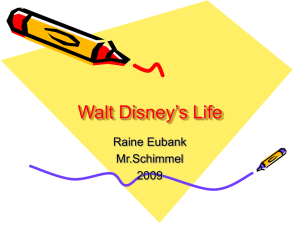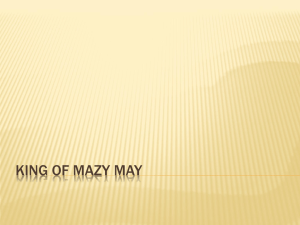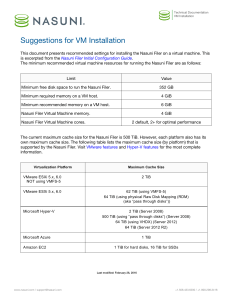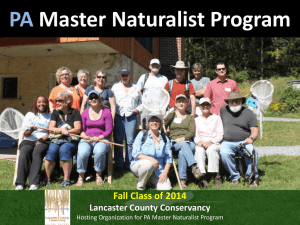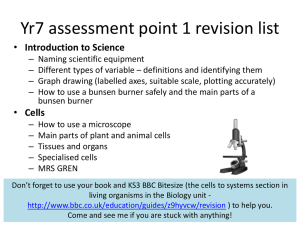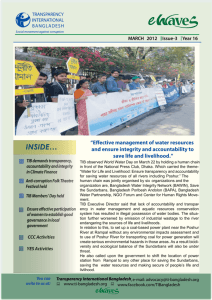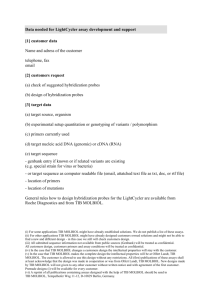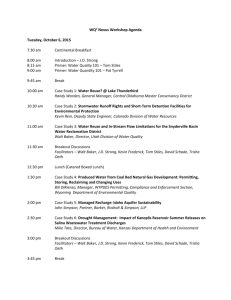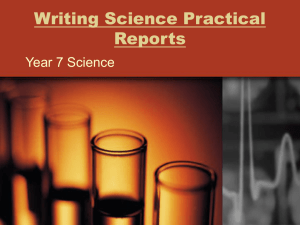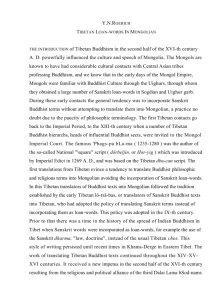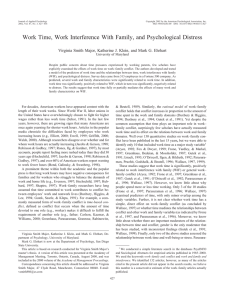Term 1 - Working in a Laboratory (Safety)
advertisement
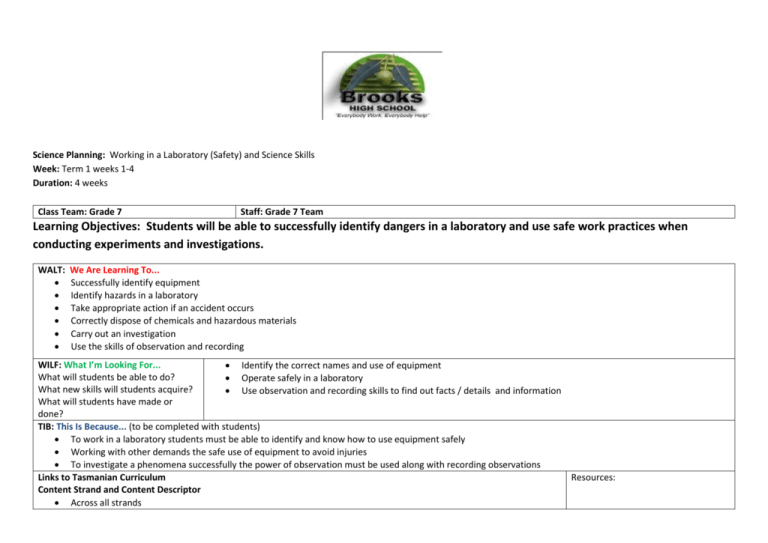
Science Planning: Working in a Laboratory (Safety) and Science Skills Week: Term 1 weeks 1-4 Duration: 4 weeks Class Team: Grade 7 Staff: Grade 7 Team Learning Objectives: Students will be able to successfully identify dangers in a laboratory and use safe work practices when conducting experiments and investigations. WALT: We Are Learning To... Successfully identify equipment Identify hazards in a laboratory Take appropriate action if an accident occurs Correctly dispose of chemicals and hazardous materials Carry out an investigation Use the skills of observation and recording WILF: What I’m Looking For... Identify the correct names and use of equipment What will students be able to do? Operate safely in a laboratory What new skills will students acquire? Use observation and recording skills to find out facts / details and information What will students have made or done? TIB: This Is Because... (to be completed with students) To work in a laboratory students must be able to identify and know how to use equipment safely Working with other demands the safe use of equipment to avoid injuries To investigate a phenomena successfully the power of observation must be used along with recording observations Links to Tasmanian Curriculum Resources: Content Strand and Content Descriptor Across all strands Whole: Warm up (5 min) Task Think Pair Share Question” Why do we need to know the names and use of pieces of equipment in the work place Sharing ideas like: taking the same language, help others, follow instructions, use equipment safely etc. Write up ideas and decide on three most important points Introduction of Cycles Focus: WALT, WILF TIB (15 min) What the pieces of equipment we use in the laboratory and what is there use Show students equipment with tagged names and describe how the equipment is used Pick several pieces of equipment and pose a hypothetical – What do you think these are used for? Resources: Resources: Science World 7 - Pages 1 - 4 Small Learning Activities: 30 Minutes WEEK 1 Resources: Whole – discuss WALT, WIF, TIB Lesson 1 What is science? Safety in the lab. Go through dos and don’ts of lab rules. Equipment needed for science experiments. Small Work through naming equipment. Have equipment out and labels and hands on match. Whole Recap by Students drawing pieces of science equipment as simple diagrams in their books. Exit card Challenge of naming pieces of equipment from a box of 10 items. Science Quest - Pages 7 Science Quest student book p1 Worksheet 1.1, 1.2 (both sides) PowerPoint: Science Equipment Whole – discuss WALT, WIF, TIB Pose the question “Why is working safely in industry take so seriously? Brainstorm ideas / suggestions and record on whiteboard Discussion of possible safety rules in the laboratory. (Recap from lesson 1) Go through hazard symbols PowerPoint. Lesson 2 Small Complete worksheet on new, old and meanings. By moving around the classroom. Whole Discussion about the correct disposal of chemical and why? Reinforce to students chemicals in the environment end up back in the ecosystem and can cause toxic side effects Exit Formative assessment 5 multi-choice questions and go through answers. Hazard_Symbols_-_f or_work_sheet.pptx Hazard_Symbols_wo rksheets_new_old_blank.doc Hazard_Symbols_wo rksheets_new_old_-_complete.doc Week 2 WholeWhat are science observations? Smell, sight, touch Remember safety, how to smell safely Teacher demonstration on candle observations-go through Faradays experiment.p12-13 in Science Quest 7. Small Lesson 3 Lesson 4 Complete observing and recording inquiry Quest 7 Draw table in books and record. Whole Why observations are so important in science? Exit Complete recording. Whole – discuss WALT, WIF, TIB Teachers outlines turning on electricity / gas in laboratories and emergency cut offs Demonstration of safe setting up and usage of a Bunsen burner Small Students undertake Investigation 1 Parts A, B and C – Using a Bunsen burner Whole Science Quest 7 Observing and recording worksheet 1.3 Science World 7 – Pages 11 – 13 Record flame colours. Discussion of questions related to Using a Bunsen Burner Equipment 1. Bunsen burner 2. Heatproof mat 3. Tripod 4. Gauze mat 5. Matches 6. Piece of copper wire 7. Metal tings 8. 250 ml beaker WEEK 3 Resources: Whole – discuss WALT, WIF, TIB Writing experimental reports – convey why reports are written Sharing ideas, repeating procedures, improving processes etc. Components of a report: Title, aim, materials, method, results, discussion and conclusion Lesson 1 Small Teach yourself how to fold filter paper Filter various mixtures like sand and water, soil and water, copper sulphate Explain why some solutions filter successfully and other do not Science World 7 – Page 14 Whole Discussion of what to put in experimental report of experiment Write a sample on the board for student to copy into their books Whole – discuss WALT, WIF, TIB Review components of a report: Title, aim, materials, method, results, discussion and conclusion Lesson 2 Small Students undertake Investigation 2 – Making milk glue Whole Discussion of what to put in experimental report of experiment Set as HW task to read copy of the draft report for the experiment Science World 7 – Page 15 - 16 Week 4 Whole – discuss WALT, WIF, TIB Review components of a report: Title, aim, materials, method, results, discussion and conclusion Discuss with students what they observed from the experimental report on Making Milk Glue Discussion why observing and recording is an important investigation skill Lesson 3 Small Students test the strength of their glue using different materials to join What is the best surface for the glue e.g. paper to wood, paper to paper, wood to wood etc. Write summary of their findings Come up with a recommendation of how the glue would best be used Whole Discuss their recommendations Talk about there are many different commercial glues like Araldite, Superglue, hot glue gun, Aquadhere Set as HW task to read copy of the draft report for the experiment Will discuss next lesson and ask questions about the experimental report Whole – discuss WALT, WIF, TIB Small Students undertake Investigation 3 – Observing and recording Whole Discussion of experimental results and answers to questions Lesson 1 Equipment 1. Limewater 2. Drinking straw 3. Flask (250 ml) 4. Test tube 5. Small piece of Zinc 6. Dilute HCl in dropping bottle 7. Spatula 8. Sodium thiosulphate crystals 9. Ink pad 10. Methylated spirits 11. Paper towel 12. Hand lens Whole – discuss WALT, WIF, TIB Fingerprints and forensic science Draw diagrams of different finger prints Set up a crime scene with several prints Get all students to put their finger points to named piece of paper Small Solve who committed the crime Lesson 2 Whole Work through chapter check / challenge / main ideas / review Science World 7 - Page 19 PowerPoint: Fingerprints Equipment Equipment 1. Ink pad 2. Methylated spirits 3. Paper towel 4. Hand lens Whole – discuss WALT, WIF, TIB Discussion of learnt skills over the past few weeks Lesson 3 Small Check / Challenge / Main Ideas / Review Making Observations Set tasks for groups of students depending upon their ability Science World 7 - Page 19 - 24 Whole Discuss answers to above sections Concluding Whole: (15 min) Call out what students have learnt For each called out item explain why? Resources: Pre and Post Assessment What will students do, say, make, write? Pre Assessment: Question students on simple pieces of Science equipment and the possible use Question students on investigation techniques Post Assessment: Students understand the use of Hazchem sheets and what actions to take for caustic spills and gas leaks Students are able to articulate the step to safely use a Bunsen Burner Students understand the steps in conducting a Science experiment Students can use skills of comparison and deduction to complete a finger print investigation
